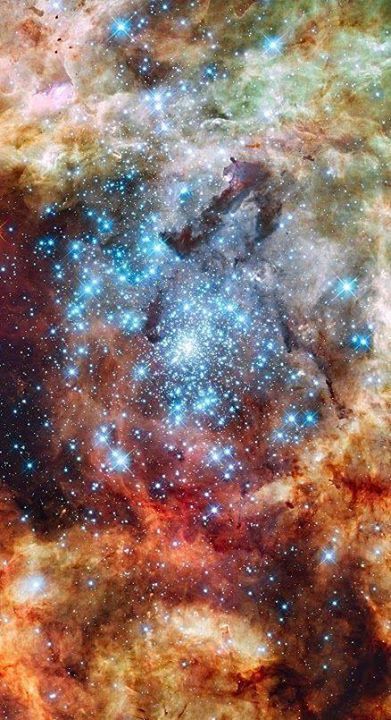Starsglaxiesspace - SPACE

More Posts from Starsglaxiesspace and Others



Merging Galaxies Bursting With Light - NGC 2207 and IC 2163
Just like our Milky Way galaxy, NGC 2207 and IC 2163 are sprinkled with many star systems known as X-ray binaries, which consist of a star in a tight orbit around either a neutron star or a stellar-mass black hole. The strong gravity of the neutron star or black hole pulls matter from the companion star. As this matter falls toward the neutron star or black hole, it is heated to millions of degrees and generates X-rays. These special objects are in a category of objects known as ultra-luminous X-ray sources (ULXs) and have been found using data from NASA’s Chandra X-ray Space Observatory. This Image is a mix of the optical and X-ray wavelength, with the optical showing the galaxies structure and the bursts of pink and purple representing concentrations of X-rays.
Credit: NASA/Chandra/Cal Tech/Harvard

Hubble Ultra Deep Field




Rosette Nebula HaRGB by Neil’s Astro on Flickr.

Astronaut John W. Young, commander of the Apollo 16 lunar landing mission, works at the Lunar Roving Vehicle (LRV) just prior to deployment of the Apollo Lunar Surface Experiments Package (ALSEP) during the first extravehicular activity (EVA-1) on April 21, 1972. [3072 x 3072]

Rosetta: “Comet from 8km”
Description A section of the smaller of Comet 67P/Churyumov–Gerasimenko’s two lobes as seen through Rosetta’s narrow-angle camera from a distance of about 8 km to the surface on 14 October 2014. The resolution is 15 cm/pixel. The image is featured on the cover of 23 January 2015 issue of the journal Science. More information: Getting to know Rosetta’s comet
Credit: ESA/Rosetta/MPS for OSIRIS Team MPS/UPD/LAM/IAA/SSO/INTA/UPM/DASP/IDA
-
 meinnim reblogged this · 6 years ago
meinnim reblogged this · 6 years ago -
 kneipho liked this · 6 years ago
kneipho liked this · 6 years ago -
 moonstar-magic liked this · 6 years ago
moonstar-magic liked this · 6 years ago -
 ambroseharte liked this · 6 years ago
ambroseharte liked this · 6 years ago -
 daemondamian liked this · 6 years ago
daemondamian liked this · 6 years ago -
 superearthquakefest liked this · 6 years ago
superearthquakefest liked this · 6 years ago -
 lionesshathor reblogged this · 6 years ago
lionesshathor reblogged this · 6 years ago -
 lionesshathor liked this · 6 years ago
lionesshathor liked this · 6 years ago -
 gunsgearsurvival7 liked this · 6 years ago
gunsgearsurvival7 liked this · 6 years ago -
 meinnim liked this · 6 years ago
meinnim liked this · 6 years ago -
 wiishingxstars reblogged this · 6 years ago
wiishingxstars reblogged this · 6 years ago -
 metalzoic liked this · 6 years ago
metalzoic liked this · 6 years ago -
 gramlog-blog liked this · 6 years ago
gramlog-blog liked this · 6 years ago -
 speedrunner-fuchs-wulf liked this · 6 years ago
speedrunner-fuchs-wulf liked this · 6 years ago -
 melisa-may-taylor72 liked this · 6 years ago
melisa-may-taylor72 liked this · 6 years ago -
 panthera--tigris--altaica liked this · 6 years ago
panthera--tigris--altaica liked this · 6 years ago -
 mleighlikes reblogged this · 6 years ago
mleighlikes reblogged this · 6 years ago -
 mleighlikes liked this · 6 years ago
mleighlikes liked this · 6 years ago -
 ajc18615425 liked this · 6 years ago
ajc18615425 liked this · 6 years ago -
 theworldismyoysterandiamthepearl liked this · 6 years ago
theworldismyoysterandiamthepearl liked this · 6 years ago -
 i-was-supposed-to-have-a-twin liked this · 6 years ago
i-was-supposed-to-have-a-twin liked this · 6 years ago -
 spacial-pieceofshit liked this · 6 years ago
spacial-pieceofshit liked this · 6 years ago -
 coonazz74 liked this · 6 years ago
coonazz74 liked this · 6 years ago -
 ooh-oooh liked this · 6 years ago
ooh-oooh liked this · 6 years ago -
 el-captain-save-a-hoe reblogged this · 6 years ago
el-captain-save-a-hoe reblogged this · 6 years ago -
 russianblue22 reblogged this · 6 years ago
russianblue22 reblogged this · 6 years ago -
 russianblue22 liked this · 6 years ago
russianblue22 liked this · 6 years ago -
 genocider-syo-is-still-my-queen liked this · 6 years ago
genocider-syo-is-still-my-queen liked this · 6 years ago -
 yxcvbnm666 liked this · 6 years ago
yxcvbnm666 liked this · 6 years ago -
 nothisacrayon liked this · 6 years ago
nothisacrayon liked this · 6 years ago -
 giorgioooo-blog1 liked this · 6 years ago
giorgioooo-blog1 liked this · 6 years ago -
 exmormonforjesus reblogged this · 6 years ago
exmormonforjesus reblogged this · 6 years ago -
 the-ghost-of-eggs-blog liked this · 6 years ago
the-ghost-of-eggs-blog liked this · 6 years ago -
 realtonystark liked this · 6 years ago
realtonystark liked this · 6 years ago -
 wookwithoutthek-blog reblogged this · 6 years ago
wookwithoutthek-blog reblogged this · 6 years ago -
 the-most-aiming-aim-to-ever-aim liked this · 6 years ago
the-most-aiming-aim-to-ever-aim liked this · 6 years ago -
 tonyequate liked this · 7 years ago
tonyequate liked this · 7 years ago -
 gage0mate reblogged this · 7 years ago
gage0mate reblogged this · 7 years ago